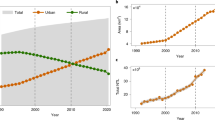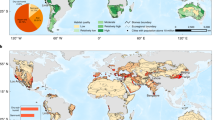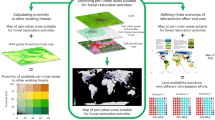Abstract
Global losses of natural area are primarily attributed to cropland expansion, whereas the role of urban expansion is considered minor. However, urban expansion can induce cropland displacement, potentially leading to a loss of forest elsewhere. The extent of this effect is unknown. This study shows that indirect forest losses, through cropland displacement, far exceed direct losses from urban expansion. On a global scale, urban land increased from 33.2 to 71.3 million hectares (Mha) between 1992 and 2015, leading to a direct loss of 3.3 Mha of forest and an indirect loss of 17.8 to 32.4 Mha. In addition, this urban expansion led to a direct loss of 4.6 Mha of shrubland and an indirect loss of 7.0 to 17.4 Mha. Guiding urban development towards more sustainable trajectories can thus help preserve forest and other natural area at a global scale.
This is a preview of subscription content, access via your institution
Access options
Access Nature and 54 other Nature Portfolio journals
Get Nature+, our best-value online-access subscription
$29.99 / 30 days
cancel any time
Subscribe to this journal
Receive 12 digital issues and online access to articles
$119.00 per year
only $9.92 per issue
Buy this article
- Purchase on Springer Link
- Instant access to full article PDF
Prices may be subject to local taxes which are calculated during checkout



Similar content being viewed by others
Data availability
Data that support the findings presented in this study are available from the author upon reasonable request.
Code availability
Scripts used for this analysis are available from the author upon reasonable request.
References
Lambin, E. F. & Meyfroidt, P. Global land use change, economic globalization, and the looming land scarcity. Proc. Natl Acad. Sci. USA 108, 3465–3472 (2011).
Newbold, T. et al. Global effects of land use on local terrestrial biodiversity. Nature 520, 45–50 (2015).
Costanza, R. et al. Changes in the global value of ecosystem services. Global Environ. Change 26, 152–158 (2014).
Tubiello, F. N. et al. The contribution of agriculture, forestry and other land use activities to global warming, 1990–2012. Glob. Change Biol. 21, 2655–2660 (2015).
Curtis, P. G., Slay, C. M., Harris, N. L., Tyukavina, A. & Hansen, M. C. Classifying drivers of global forest loss. Science 361, 1108–1111 (2018).
Geist, H. J. & Lambin, E. F. Proximate causes and underlying driving forces of tropical deforestation. Bioscience 52, 143–150 (2002).
Alexander, P. et al. Drivers for global agricultural land use change: the nexus of diet, population, yield and bioenergy. Global Environ. Change 35, 138–147 (2015).
Erb, K.-H. et al. Exploring the biophysical option space for feeding the world without deforestation. Nat. Commun. 7, 11382 (2016).
Rudel, T. K. et al. Agricultural intensification and changes in cultivated areas, 1970–2005. Proc. Natl Acad. Sci. USA 106, 20675–20680 (2009).
DeFries, R. S., Rudel, T., Uriarte, M. & Hansen, M. Deforestation driven by urban population growth and agricultural trade in the twenty-first century. Nat. Geosci. 3, 178–181 (2010).
Meyfroidt, P., Lambin, E. F., Erb, K.-H. & Hertel, T. W. Globalization of land use: distant drivers of land change and geographic displacement of land use. Curr. Opin. Env. Sust. 5, 438–444 (2013).
Avellan, T., Meier, J. & Mauser, W. Are urban areas endangering the availability of rainfed crop suitable land? Remote Sens. Lett. 3, 631–638 (2012).
Gibbs, H. K. et al. Tropical forests were the primary sources of new agricultural land in the 1980s and 1990s. Proc. Natl Acad. Sci. USA 107, 16732–16737 (2010).
Ke, X. et al. Direct and indirect loss of natural habitat due to built-up area expansion: a model-based analysis for the city of Wuhan, China. Land Use Policy 74, 231–239 (2018).
van Vliet, J., Eitelberg, D. A. & Verburg, P. H. A global analysis of land take in cropland areas and production displacement from urbanization. Global Environ. Change 43, 107–115 (2017).
European Space Agency Climate Change Initiative Land Cover http://maps.elie.ucl.ac.be/CCI/viewer/index.php (2015).
Armenteras, D., Espelta, J. M., Rodríguez, N. & Retana, J. Deforestation dynamics and drivers in different forest types in Latin America: three decades of studies (1980–2010). Global Environ. Chang. 46, 139–147 (2017).
Barona, E., Ramankutty, N., Hyman, G. & Coomes, O. T. The role of pasture and soybean in deforestation of the Brazilian Amazon. Environ. Res. Lett. 5, 024002 (2010).
Pesaresi, M. et al. GHS Built-up Grid, Derived from Landsat, Multitemporal (1975, 1990, 2000, 2014) (European Commission, Joint Research Centre, accessed 1 January 2017); http://data.europa.eu/89h/jrc-ghsl-ghs_built_ldsmt_globe_r2015b
Liu, X. et al. High-resolution multi-temporal mapping of global urban land using Landsat images based on the Google Earth engine platform. Remote Sens. Environ. 209, 227–239 (2018).
Liu, Z., He, C., Zhou, Y. & Wu, J. How much of the world’s land has been urbanized, really? A hierarchical framework for avoiding confusion. Landscape Ecol. 29, 763–771 (2014).
Potere, D. & Schneider, A. A critical look at representations of urban areas in global maps. GeoJournal 69, 55–80 (2007).
D’Odorico, P., Carr, J. A., Laio, F., Ridolfi, L. & Vandoni, S. Feeding humanity through global food trade. Earths Future 2, 458–469 (2014).
Weinzettel, J., Hertwich, E. G., Peters, G. P., Steen-Olsen, K. & Galli, A. Affluence drives the global displacement of land use. Global Environ. Change 23, 433–438 (2013).
Qiang, W., Liu, A., Cheng, S., Kastner, T. & Xie, G. Agricultural trade and virtual land use: the case of China’s crop trade. Land Use Policy 33, 141–150 (2013).
Foley, J. A. et al. Solutions for a cultivated planet. Nature 478, 337–342 (2011).
Kuemmerle, T. et al. Challenges and opportunities in mapping land use intensity globally. Curr. Opin. Env. Sust. 5, 484–493 (2013).
Byerlee, D., Stevenson, J. & Villoria, N. Does intensification slow crop land expansion or encourage deforestation? Glob. Food Secur.-Agr. 3, 92–98 (2014).
Tabeau, A., Helming, J. & Philippidis, G. Land Supply Elasticities (Publications Office of the European Union, 2017).
Vijay, V., Pimm, S. L., Jenkins, C. N. & Smith, S. J. The impacts of oil palm on recent deforestation and biodiversity loss. PLoS ONE 11, e0159668 (2016).
Meyfroidt, P. et al. Multiple pathways of commodity crop expansion in tropical forest landscapes. Environ. Res. Lett. 9, 074012 (2014).
Gasparri, N. I., Grau, H. R. & Gutiérrez Angonese, J. Linkages between soybean and neotropical deforestation: coupling and transient decoupling dynamics in a multi-decadal analysis. Global Environ. Change 23, 1605–1614 (2013).
Fehlenberg, V. et al. The role of soybean production as an underlying driver of deforestation in the South American Chaco. Global Environ. Change 45, 24–34 (2017).
Angel, S., Parent, J., Civco, D. L., Blei, A. & Potere, D. The dimensions of global urban expansion: estimates and projections for all countries, 2000–2050. Prog. Plann. 75, 53–107 (2011).
Fragkias, M., Güneralp, B., Seto, K. C. & Goodness, J. A. in Urbanization, Biodiversity and Ecosystem Services: Challenges and Opportunities (eds Elmqvist T. et al.) 409–435 (Springer Netherlands, 2013).
Bren d’Amour, C. et al. Future urban land expansion and implications for global croplands. Proc. Natl Acad. Sci. USA 114, 8939–8944 (2017).
Seto, K. C., Guneralp, B. & Hutyra, L. R. Global forecasts of urban expansion to 2030 and direct impacts on biodiversity and carbon pools. Proc. Natl Acad. Sci. USA 109, 16083–16088 (2012).
Cumming, G. S. et al. Implications of agricultural transitions and urbanization for ecosystem services. Nature 515, 50–57 (2014).
Liu, Y., Fang, F. & Li, Y. Key issues of land use in China and implications for policy making. Land Use Policy 40, 6–12 (2014).
Schneider, A. & Woodcock, C. E. Compact, dispersed, fragmented, extensive? A comparison of urban growth in twenty-five global cities using remotely sensed data, pattern metrics and census information. Urban Stud. 45, 659–692 (2008).
Chen, H., Jia, B. & Lau, S. S. Y. Sustainable urban form for Chinese compact cities: challenges of a rapid urbanized economy. Habitat Int. 32, 28–40 (2008).
Cortinovis, C., Haase, D., Zanon, B. & Geneletti, D. Is urban spatial development on the right track? Comparing strategies and trends in the European Union. Landscape Urban Plan. 181, 22–37 (2019).
Boyle, R. & Mohamed, R. State growth management, smart growth and urban containment: a review of the US and a study of the heartland. J. Environ. Plann. Man. 50, 677–697 (2007).
Bunker, R. How Is the compact city faring in Australia? Plan. Pract. Res. 29, 449–460 (2014).
Watson, V. Seeing from the south: refocusing urban planning on the globe’s central urban issues. Urban Stud. 46, 2259–2275 (2009).
Westerink, J. et al. Dealing with sustainability trade-offs of the compact city in peri-urban planning across European city regions. Eur. Plan. Stud. 21, 473–497 (2013).
Pouzols, F. M. et al. Global protected area expansion is compromised by projected land-use and parochialism. Nature 516, 383–386 (2014).
Michetti, M. & Zampieri, M. Climate–human–land interactions: a review of major modelling approaches. Land 3, 793–833 (2014).
Levis, S. Modeling vegetation and land use in models of the Earth System. WIREs Clim. Change 1, 840–856 (2010).
van Vliet, J., Verburg, P. H., Grădinaru, S. R. & Hersperger, A. M. Beyond the urban-rural dichotomy: towards a more nuanced analysis of changes in built-up land. Comput. Environ. Urban. 74, 41–49 (2019).
Kastner, T., Erb, K.-H. & Haberl, H. Rapid growth in agricultural trade: effects on global area efficiency and the role of management. Environ. Res. Lett. 9, 034015 (2014).
Yu, Y., Feng, K. & Hubacek, K. Tele-connecting local consumption to global land use. Global Environ. Change 23, 1178–1186 (2013).
Poulter, B. et al. Plant functional type classification for earth system models: results from the European Space Agency’s land cover climate change initiative. Geosci. Model Dev. 8, 2315–2328 (2015).
Li, W. et al. Gross and net land cover changes in the main plant functional types derived from the annual ESA CCI land cover maps (1992–2015). Earth Syst. Sci. Data 10, 219–234 (2018).
European Space Agency Climate Change Initiative Land Cover CCI Product User Guide v.2.0 http://maps.elie.ucl.ac.be/CCI/viewer/download/ESACCI-LC-Ph2-PUGv2_2.0.pdf (2017).
Di Gregorio, A. Land Cover Classification System (LCCS); Classification Concepts and User Manual; Software v.2. Environment and Natural Resources Series No. 8 (Food and Agriculture Organization of the United Nations, 2005).
Neumann, K., Verburg, P. H., Stehfest, E. & Müller, C. The yield gap of global grain production: a spatial analysis. Agr. Syst. 103, 316–326 (2010).
van Asselen, S. & Verburg, P. H. A land system representation for global assessments and land-use modeling. Glob. Change Biol. 18, 3125–3148 (2012).
Monfreda, C., Ramankutty, N. & Foley, J. A. Farming the planet: 2. geographic distribution of crop areas, yields, physiological types, and net primary production in the year 2000. Glob. Biogeochem. Cycles 22, GB1022 (2008).
Ramankutty, N., Evan, A. T., Monfreda, C. & Foley, J. A. Farming the planet: 1. geographic distribution of global agricultural lands in the year 2000. Glob. Biogeochem. Cycles 22, GB1003 (2008).
Mueller, N. D. et al. Closing yield gaps through nutrient and water management. Nature 490, 254–257 (2012).
Nutritive Factors (Food and Agriculture Organization of the United Nations, accessed 27 February 2019); http://www.fao.org/fileadmin/templates/ess/ess_test_folder/Food_security/Excel_sheets/Nutritive_Factors.xls
Acknowledgements
J.v.V. thanks R. Prestele for his help with the spatial data analysis. This project was supported by NWO-WOTRO project no. W 07.303.108 on joint SDG research. This paper contributes to the Global Land Programme (https://glp.earth).
Author information
Authors and Affiliations
Contributions
J.v.V. designed the study, conducted the data analysis and wrote the paper.
Corresponding author
Ethics declarations
Competing interests
The author declares no competing interests.
Additional information
Publisher’s note: Springer Nature remains neutral with regard to jurisdictional claims in published maps and institutional affiliations.
Supplementary information
Supplementary Information
Supplementary Fig. 1, Supplementary Tables 1–12, Supplementary References 1–5
Rights and permissions
About this article
Cite this article
van Vliet, J. Direct and indirect loss of natural area from urban expansion. Nat Sustain 2, 755–763 (2019). https://doi.org/10.1038/s41893-019-0340-0
Received:
Accepted:
Published:
Issue Date:
DOI: https://doi.org/10.1038/s41893-019-0340-0
This article is cited by
-
Dynamic urban land extensification is projected to lead to imbalances in the global land-carbon equilibrium
Communications Earth & Environment (2024)
-
Understanding habitat isolation in the context of construction land expansion using an ecological network approach
Landscape Ecology (2024)
-
Black-tailed deer resource selection reveals some mechanisms behind the ‘luxury effect’ in urban wildlife
Urban Ecosystems (2024)
-
The neglected role of abandoned cropland in supporting both food security and climate change mitigation
Nature Communications (2023)
-
Delhi urbanization footprint and its effect on the earth’s subsurface state-of-stress through decadal seismicity modulation
Scientific Reports (2023)



